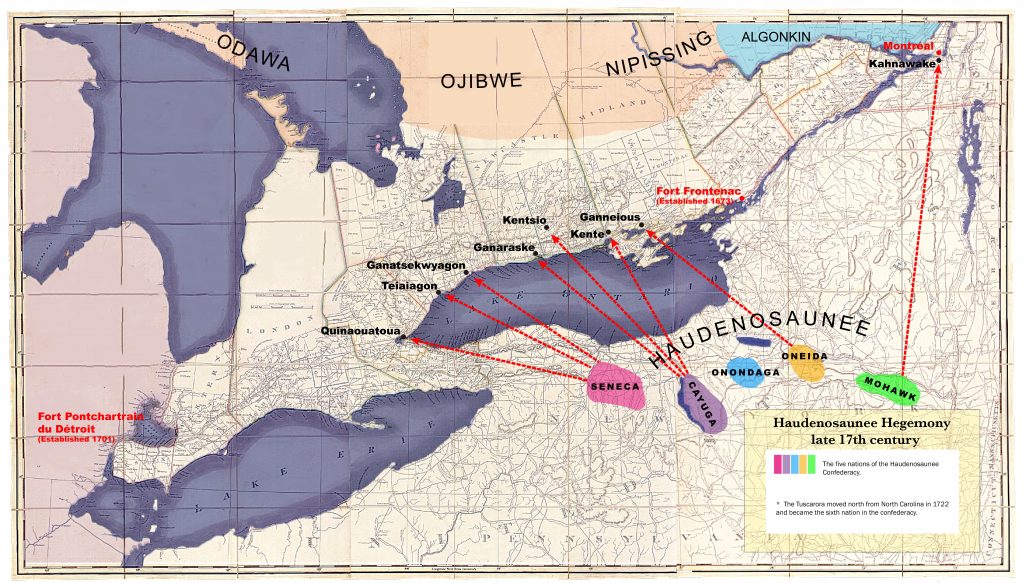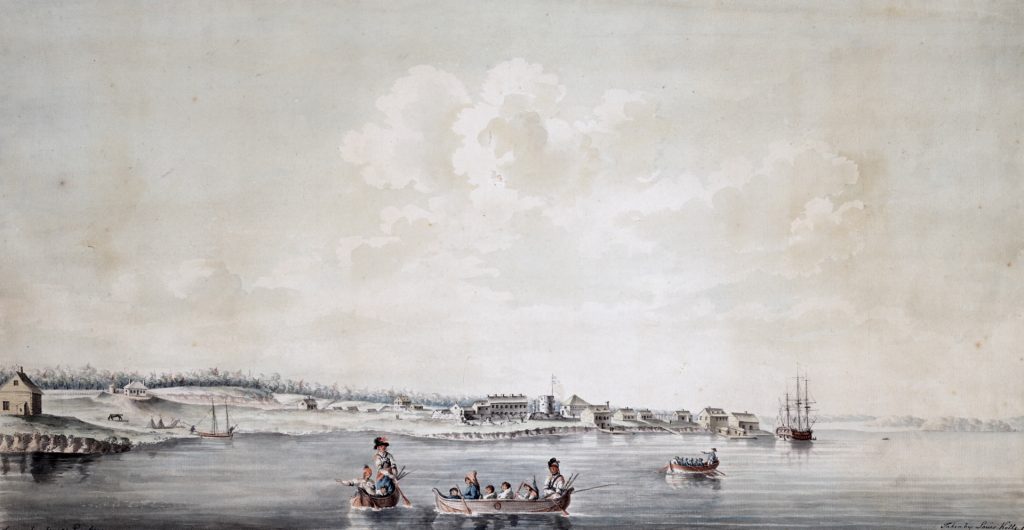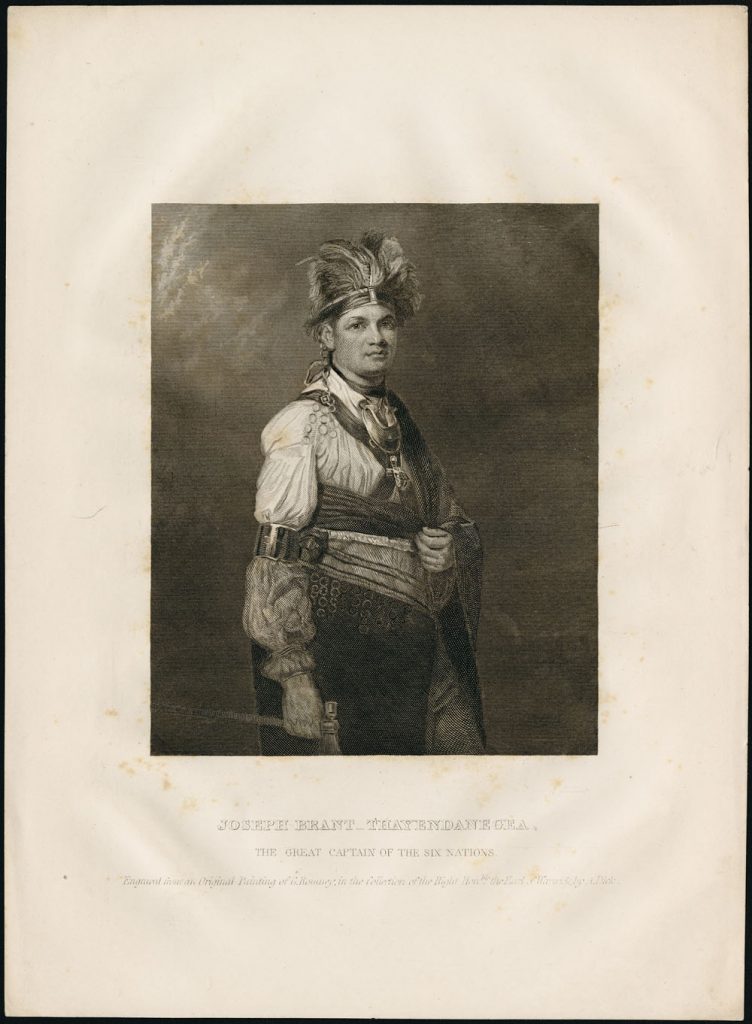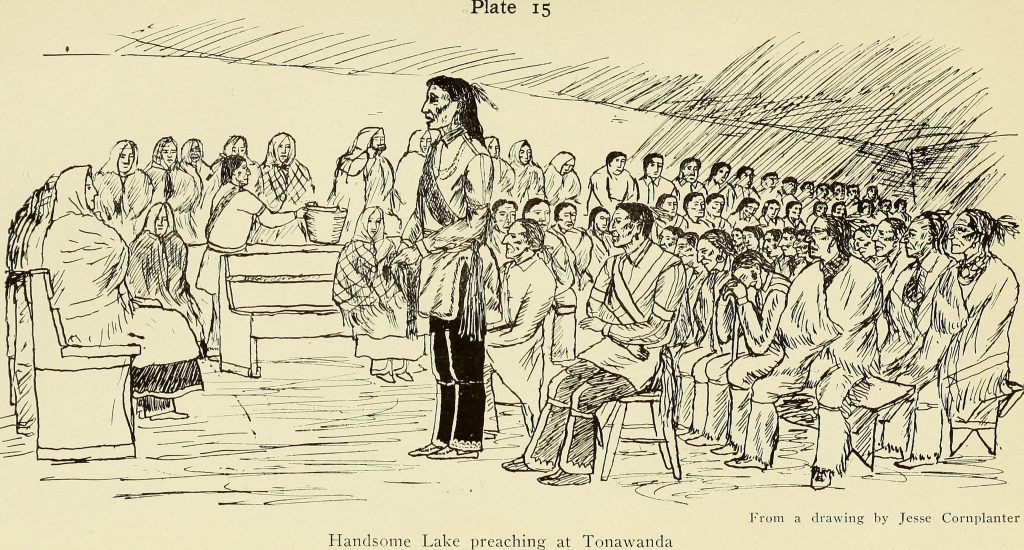9. Haudenosaunee
The Haudenosaunee
Today the indigenous population of the Lake Simcoe/Georgian Bay area is overwhelmingly Anishinaabe although there is a small Mohawk reserve in Gibson Township, near Bala in the District of Parry Sound. By a quirk of history, the same people who so radically altered the human geography of this area returned peacefully in 1885.
 The Haudenosaunee Confederacy will ever be remembered as the destroyers of Wendake and the Tionontatehronnon homeland and the terrorizers of the villages and Seigneuries of New France. After the defeat of the Wendat, Tionontatehronnon and Neutral nations, the Haudenosaunee became the inhabitants of southern Ontario with several villages having been built on the north shore of Lake Ontario. By the late 17th century, these settlements were abandoned and the Anishinaabeg were in possession north of Lake Ontario. Another shift of fate would again alter the situation. With the defeat of loyalist forces in the American Revolution, many Haudenosaunee fled to British territory in the future colony of Upper Canada.
The Haudenosaunee Confederacy will ever be remembered as the destroyers of Wendake and the Tionontatehronnon homeland and the terrorizers of the villages and Seigneuries of New France. After the defeat of the Wendat, Tionontatehronnon and Neutral nations, the Haudenosaunee became the inhabitants of southern Ontario with several villages having been built on the north shore of Lake Ontario. By the late 17th century, these settlements were abandoned and the Anishinaabeg were in possession north of Lake Ontario. Another shift of fate would again alter the situation. With the defeat of loyalist forces in the American Revolution, many Haudenosaunee fled to British territory in the future colony of Upper Canada.
 History tends to paint a picture of the Five Nations as ferocious warriors if not “bloodthirsty savages”. But, the Haudenosaunee were very much like their Iroquoian speaking neighbours: the Wendat, Tionontatehronnon, Erie, Neutral and Susquehannock. They were, like their neighbours, an agrarian people residing in villages, with similar political structures and many common cultural customs. Traditionally, warfare was a relatively low-level affair with seasonal raids on enemy villages in search of revenge for past attacks and killings by the other side. Warriors sought status through their bravery in battle.
History tends to paint a picture of the Five Nations as ferocious warriors if not “bloodthirsty savages”. But, the Haudenosaunee were very much like their Iroquoian speaking neighbours: the Wendat, Tionontatehronnon, Erie, Neutral and Susquehannock. They were, like their neighbours, an agrarian people residing in villages, with similar political structures and many common cultural customs. Traditionally, warfare was a relatively low-level affair with seasonal raids on enemy villages in search of revenge for past attacks and killings by the other side. Warriors sought status through their bravery in battle.
Champlain’s ill-considered attack, along with Wendat and Algonkian allies, on the Haudenosaunee Confederacy near Lake Onondaga in 1615, however, may have increased the intensity of the long-standing conflict between the Wendat and Five Nations. Jealousy over the Wendat position in the fur trade may have been an important motivating factor for the eventual destruction of Wendake.
The destruction of their neighbours did not end this extraordinary burst of militaristic energy on the part of the Haudenosaunee. After the reduction of the Neutral Nations of Southwestern Ontario and the Erie at the eastern end of Lake Erie, the Haudenosaunee continued their raids into the Canadian Shield and west into the Ohio Valley. A major war was begun with the Susquehannock to the south and sporadic conflict continued with the French.
The Haudenosaunee were a confederation of five nations. Haudenosaunee is translated as “people of the extended lodge”. The lodge or longhouse analogy was applied to the confederation. The Seneca in the west and Mohawk in the east were regarded as the gatekeepers and the Onondaga in the centre as the keepers of the sacred fire. The Cayuga and Oneida had no special symbolic designation within the confederacy. Each nation was free to pursue its own interests within the confederation. During ordinary times, this arrangement did not cause difficulty but, during the period of incessant warfare in the 17th century, the relationship of the Five Nations was strained. The Mohawks had always been most affected by war with the French and desired to concentrate the energies of the confederation on this conflict. The western nations, however, pursued their war against the Susquehannock. In order to free themselves from French interference, the four western nations led by the Onondaga concluded a peace agreement with the French in 1665. The Mohawk remained aloof from the peace treaty.

Historians have largely ignored the short period of Haudenosaunee dominance in Southern Ontario. Although some contact between the French and Five Nations was made and trade between the north shore villages and Albany continued, very few European accounts of the area exist. We know that the Seneca established the villages of Teiaiagon and Ganatsekwyagon on the Humber and Rouge Rivers respectively. The Cayuga built three villages to the east of the Seneca settlements. They were Ganaraske, Kentsio and Kente. The Oneida settled near modern day Napanee calling their village Ganneious. Other villages may have been built further inland but for the most part the rest of the peninsula was used as a hunting ground.
From a geographical point of view, it is interesting to note that the Haudenosaunee villages all straddled routes to the Upper Great Lakes via Lake Simcoe. The Humber River valley formed part of the Toronto Carrying Place – the fastest route from Lake Ontario to Georgian Bay. The Rouge River was occasionally used as an alternate route to Lake Simcoe. The four settlements to the east all had easy access to the Trent Valley, yet another route. Whether these locations provided easy access to the northern trade routes for the purpose of raiding or simply made the hunting grounds of the interior easier to reach is unclear. It must be remembered, however, that lakes and rivers were the highways of this time. The Lake Simcoe-Georgian Bay area continued to hold a strategic importance even after the depopulation of 1650.
The Haudenosaunee had angered their new northern neighbours with their raids and open warfare broke out between the Anishinaabeg and Haudenosaunee. The exact date of the Anishinaabe advance into Southern Ontario is unknown but, by the early years of the 18th century, the Anishinaabeg, not the Haudenosaunee, were in possession of the north shore of Lake Ontario. Anishinaabe oral history tells of the assembly of an Anishinaabe war party at the fish weirs between Lakes Couchiching and Simcoe. The result of the coming battle was foretold and depicted on the rocks of Quarry Point in Lake Couchiching. The painting has since disappeared but a famous reproduction was created by a resident of Rama Reserve named Mesaquab (Jonathan Yorke) around 1900.
The Haudenosaunee occupation of Southern Ontario was relatively brief; settlement appears to have started around 1665. The villages on the north shore of Lake Ontario were all destroyed around 1700 and the surviving Haudenosaunee fled to the south. The Five Nations had been weakened by continuous warfare and quickly agreed to peace with the Anishinaabeg. A wampum belt was made to acknowledge the peace. It was brought out when William Yellowhead had occasion to remind representatives of the Haudenosaunee of their defeat and cession of Southern Ontario.
Though the Five Nations ceded Southern Ontario somewhere around 1700, European maps persisted in including the Haudenosaunee “castles” on the north shore of Lake Ontario until the end of the 18th century! This oversight has only confounded any understanding of this time period in Southern Ontario.
The Haudenosaunee would return to Ontario in numbers after the American Revolution. This war had badly divided the confederation. The Mohawks, and eventually the three western nations, joined the Loyalist forces in opposing the rebels. The Oneida and Tuscarora, on the other hand, sided with the Americans. The council fire was temporarily extinguished. Many Loyalist Haudenosaunee chose to flee to Upper Canada rather than trust in the good will of the nascent Republic. These indigenous Loyalists were reluctantly accepted by the Anishinaabe inhabitants who had forced them out of the area a century earlier. In his memoirs, Peter Jones describes the guarded relationship of the two old enemies that still existed in the 19th century in Southern Ontario.
The large reserve established by Tayendanegea (Joseph Brant) on the Grand River in 1784 dominates our perceptions of the Haudenosaunee in Canada. The ancestors of the Haudenosaunee of Ontario actually arrived in several waves of migration and established five reserves in the province between 1750 and 1880.
The first of the modern day reserves to be established was Akwesasne (St. Regis) near Cornwall. Established by a splinter group from the Mohawk reserve of Kanawake, in Quebec, the settlement helped to solidify the French hold on the St. Lawrence River. Like Kanawake, Akwesasne was built around a Jesuit mission. The defeat of the French in 1760 did not significantly alter the fortunes of its inhabitants but the American Revolution saw an international boundary drawn through the centre of the community. Today, the reserve straddles the borders of New York State and the provinces of Ontario and Quebec.

The aftermath of the American Revolution saw the largest flow of emigrants from Iroquoia. The Mohawk Captain John Deserontyon and his followers founded the reserve on the Bay of Quinte known as Tyendinaga. The establishment of this reserve was quickly followed by the large reserve on the Grand River under Thayendanegea (Joseph Brant).
The reserves in Upper Canada up to this point were a representation of the divisions in the Haudenosaunee Confederacy. Mohawks represented a majority of the inhabitants. In their homelands in the Mohawk Valley, in modern day New York State, the Mohawk were closest to both the French and the British. This geographic position gave them a great advantage in trade with the Europeans but also made them vulnerable to European disease, encroachment by settlers and made their territory the battleground between the rival European empires. This distinction led to differing interests that can be traced back to the 17th century.
Although the largest group on the Six Nations Reserve, the Mohawk were joined by enough members of the other nations to allow them to reconstitute the Longhouse in Canada. None of the other reserves were able to duplicate this accomplishment. They lacked the numbers and the diversity of membership to allow many traditional practices. When the Department of Indian Affairs began their assault on traditional customs, other reserves were less able to resist.
The next wave of migrants into Ontario came in response to pressure by the American government to cede land and/or accept relocation to the west. In the early 1840s, a group of about 300 Oneida bought a tract of 2100 hectares of land on the Thames River in southwestern Ontario. The Oneida had supported the rebels in the American Revolution and the division caused by their decision almost destroyed the Haudenosaunee League. This rift was partially settled by their membership in the Six Nations Confederacy of Canada.
Many divisions developed in the various Haudenosaunee communities throughout the 19th and 20th centuries. In 1876, the Canadian Government passed the Indian Act. A portion of this bill outlawed the traditional appointed councils and imposed elected government on all Canadian reserves. This imposition was fought most resolutely by the Haudenosaunee as their traditions of governance were a proud aspect of their culture. When tensions flared on the Mohawk reserve of Kanesatake (Oka) in the summer of 1990, the struggle between elected and appointed councils still raged.

Another division that developed on Haudenosaunee reserves and still resonates today is the competition between Christian and Traditionalist beliefs. Haudenosaunee Traditionalists have endured better than in other indigenous cultures partly because they have a specific written doctrine to follow. The Longhouse religion resulted from the near death experience of a Seneca sachem named Ganeodiyo or Handsome Lake.
The compelling story of Ganeodiyo began in 1799. The Six Nations (as they became in 1722 with the addition of the Tuscarora) were at their lowest ebb, particularly south of the Great Lakes. The American Revolution had split their confederation; the new Republic had imposed harsh terms on the League. White settlers were invading their homeland; Haudenosaunee numbers had decreased due to alcohol, disease and warfare. On his deathbed, Handsome Lake had a vision that told him what the people would have to do to save themselves. In part the vision represented a return to traditional ways but it also introduced some new ideas.
Most Haudenosaunee eventually accepted some form of Christianity. Communities that had been established with the help of the French Regime tended to be practitioners of Roman Catholicism whereas those that were established later tended toward the Protestant sects. There was, however, a fierce rivalry. One such competition for souls took place on the reserve of Kanesatake in Quebec in the 1870s. The debate over title to the land that would eventually result in the so-called “Oka summer” was bubbling to the surface. Methodist preachers, who backed the Haudenosaunee claims, managed to win a number of converts over from the Catholic Church. In an effort to remove the most vocal protesters, the Canadian Government decided to move the Methodist Mohawks to a separate reserve.
A site was selected in the Muskoka District of Ontario in 1880. Approximately 25 families moved to the 6000 hectare reserve in Gibson Township. The group immediately began to clear land for agriculture. Much of the effort was communal. The area also presented the opportunity for hunting and fishing and these activities helped to sustain the community in a region of marginally arable land. Agriculture had waned as a primary pursuit as on most reserves in Ontario. Many band members worked in the lumber industry but the familiar problem of finding meaningful employment in a relatively remote area persists today.
The reserve in Gibson Township is now called Wahta Mohawk. It represents the only Haudenosaunee population in the Lake Simcoe-Georgian Bay region but the ancestors of these people have cut a broad swath through history.